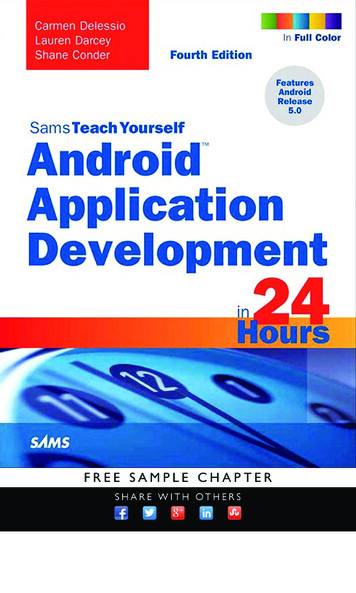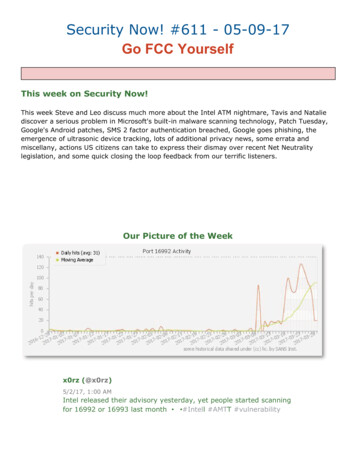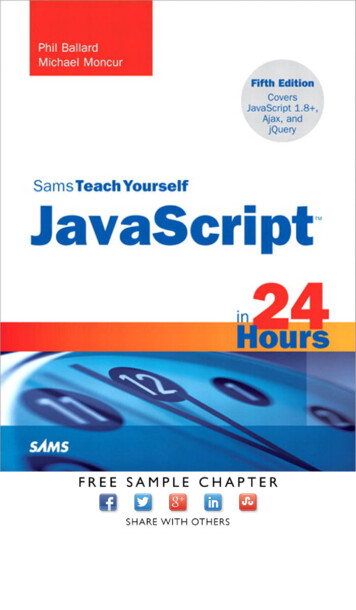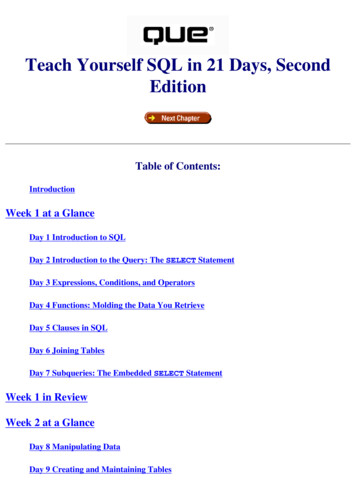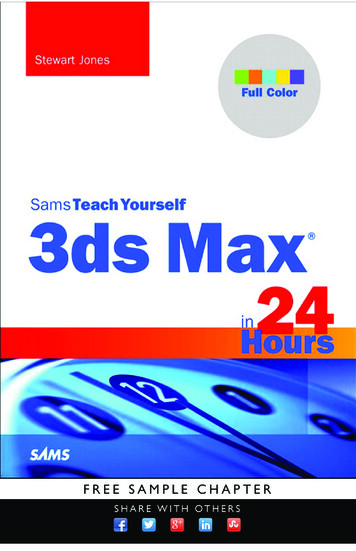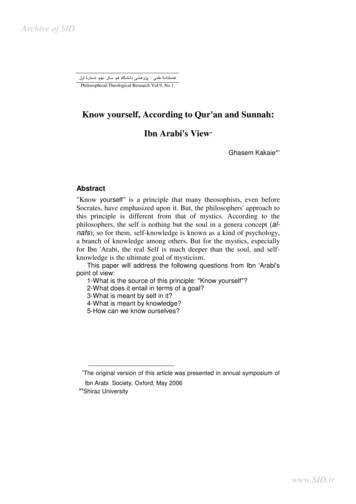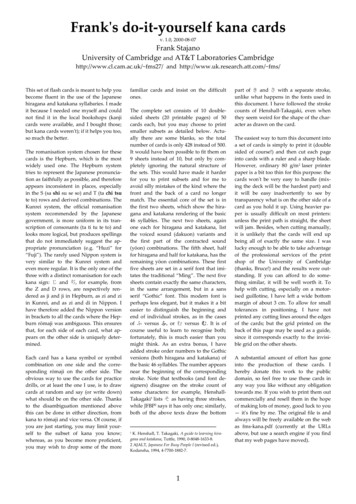
Transcription
Frank's do-it-yourself kana cardsv. 1.0, 2000-08-07Frank StajanoUniversity of Cambridge and AT&T Laboratories Cambridgehttp://www.cl.cam.ac.uk/ fms27/ and http://www.uk.research.att.com/ fms/This set of flash cards is meant to help youbecome fluent in the use of the Japanesehiragana and katakana syllabaries. I madeit because I needed one myself and couldnot find it in the local bookshops (kanjicards were available, and I bought those;but kana cards weren't); if it helps you too,so much the better.The romanisation system chosen for thesecards is the Hepburn, which is the mostwidely used one. The Hepburn systemtries to represent the Japanese pronunciation as faithfully as possible, and thereforeappears inconsistent in places, especiallyin the S (sa shi su se so) and T (ta chi tsute to) rows and derived combinations. TheKunrei system, the official romanisationsystem recommended by the Japanesegovernment, is more uniform in its transcription of consonants (ta ti tu te to) andlooks more logical, but produces spellingsthat do not immediately suggest the appropriate pronunciation (e.g. “Huzi” for“Fuji”). The rarely used Nippon system isvery similar to the Kunrei system andeven more regular. It is the only one of thethree with a distinct romanisation for eachkana sign: じ and ぢ, for example, fromthe Z and D rows, are respectively rendered as ji and ji in Hepburn, as zi and ziin Kunrei, and as zi and di in Nippon. Ihave therefore added the Nippon versionin brackets to all the cards where the Hepburn rōmaji was ambiguous. This ensuresthat, for each side of each card, what appears on the other side is uniquely determined.Each card has a kana symbol or symbolcombination on one side and the corresponding rōmaji on the other side. Theobvious way to use the cards for practicedrills, or at least the one I use, is to drawcards at random and say (or write down)what should be on the other side. Thanksto the disambiguation mentioned abovethis can be done in either direction, fromkana to rōmaji and vice versa. Of course, ifyou are just starting, you may limit yourself to the subset of kana you know;whereas, as you become more proficient,you may wish to drop some of the morefamiliar cards and insist on the difficultones.The complete set consists of 10 doublesided sheets (20 printable pages) of 50cards each, but you may choose to printsmaller subsets as detailed below. Actually there are some blanks, so the totalnumber of cards is only 428 instead of 500.It would have been possible to fit them on9 sheets instead of 10, but only by completely ignoring the natural structure ofthe sets. This would have made it harderfor you to print subsets and for me toavoid silly mistakes of the kind where thefront and the back of a card no longermatch. The essential core of the set is inthe first two sheets, which show the hiragana and katakana rendering of the basic46 syllables. The next two sheets, againone each for hiragana and katakana, listthe voiced sound (dakuon) variants andthe first part of the contracted sound(yōon) combinations. The fifth sheet, halffor hiragana and half for katakana, has theremaining yōon combinations. These firstfive sheets are set in a serif font that imitates the traditional “Ming”. The next fivesheets contain exactly the same characters,in the same arrangement, but in a sansserif “Gothic” font. This modern font isperhaps less elegant, but it makes it a biteasier to distinguish the beginning andend of individual strokes, as in the casesof ふ versus ふ, or む versus む. It is ofcourse useful to learn to recognise both;fortunately, this is much easier than youmight think. As an extra bonus, I haveadded stroke order numbers to the Gothicversions (both hiragana and katakana) ofthe basic 46 syllables. The number appearsnear the beginning of the correspondingstroke. Note that textbooks (and font designers) disagree on the stroke count ofsome characters: for example, HenshallTakagaki1 lists そ as having three strokes,while JFBP2 says it has only one; similarly,both of the above texts draw the bottom1K. Henshall, T. Takagaki, A guide to learning hiragana and katakana, Tuttle, 1990, 0-8048-1633-8.2 AJALT, Japanese For Busy People I (revised ed.),Kodansha, 1994, 4-7700-1882-7.1part of き and さ with a separate stroke,unlike what happens in the fonts used inthis document. I have followed the strokecounts of Henshall-Takagaki, even whenthey seem weird for the shape of the character as drawn on the card.The easiest way to turn this document intoa set of cards is simply to print it (doublesided of course!) and then cut each pageinto cards with a ruler and a sharp blade.However, ordinary 80 g/m2 laser printerpaper is a bit too thin for this purpose: thecards won't be very easy to handle (mixing the deck will be the hardest part) andit will be easy inadvertently to see bytransparency what is on the other side of acard as you hold it up. Using heavier paper is usually difficult on most printers:unless the print path is straight, the sheetwill jam. Besides, when cutting manually,it is unlikely that the cards will end upbeing all of exactly the same size. I waslucky enough to be able to take advantageof the professional services of the printshop of the University of Cambridge(thanks, Bruce!) and the results were outstanding. If you can afford to do something similar, it will be well worth it. Tohelp with cutting, especially on a motorised guillotine, I have left a wide bottommargin of about 3 cm. To allow for smalltolerances in positioning, I have notprinted any cutting lines around the edgesof the cards; but the grid printed on theback of this page may be used as a guide,since it corresponds exactly to the invisible grid on the other sheets.A substantial amount of effort has goneinto the production of these cards. Ihereby donate this work to the publicdomain, so feel free to use these cards inany way you like without any obligationtowards me. If you wish to print them outcommercially and resell them in the hopeof making lots of money, good luck to you— it's fine by me. The original file is andalways will be freely available on the webas fms-kana.pdf (currently at the URLsabove, but use a search engine if you findthat my web pages have moved).
Cutting guideHere is an index to the contents of this document, whichmay be useful if you onlywish to print a subset of thecards.Pages 1-2Introduction,reference cutting gridand indexPages 7-8Pages 9-10Pages 11-12Katakana basic syllables(Ming-style typeface)Hiragana dakuonand first part of yōon(Ming-style typeface)Katakana dakuonand first part of yōon(Ming-style typeface)Remainder of hiraganaand katakana yōon(Ming-style typeface)Pages 13-14Pages 15-16Pages 17-18Pages 19-20Pages 21-22Hiragana basic syllableswith stroke order numbers(Gothic-style typeface)Katakana basic syllableswith stroke order numbers(Gothic -style typeface)Hiragana dakuonand first part of yōon(Gothic -style typeface)Katakana dakuonand first part of yōon(Gothic -style typeface)Remainder of hiraganaand katakana yōon(Gothic -style typeface)Frank’sdo-it-yourself kana cardsFrank’sdo-it-yourself kana cardshttp://www.uk.research.att.com/ fms/fms-kana.pdfhttp://www.cl.cam.ac.uk/ fms27/fms-kana.pdfPages 3-4Pages 5-6Hiragana basic syllables(Ming-style typeface)2
��もやらわゆりるん3よれろを
aganahiragana4
��モユヤラワリルン5ヨレロヲ
akanakatakana6
�ぶべぼぱぴぷぺぽきゃ きゅ きょしゃ しゅ しょちゃ ちゅ ちょにゃ にゅ にょひゃ ひゅ ひょ7
ji(zi)hiraganaji(di)zahiraganada
�ブベボパピプペポキャ キュ キョシャ シュ ショチャ チュ チョニャ ニュ ニョヒャ ヒュ ヒョ9
)ji(zi)katakanaji(di)zakatakanada
みゃ りゃ ぎゃ じゃ ぢゃみゅ りゅ ぎゅ じゅ ぢゅみょ りょ ぎょ じょ ぢょびゃ びゅ びょぴゃ ぴゅ ぴょミャ リャ ギャ ジャ ヂャミュ リュ ギュ ジュ ヂュミョ リョ ギョ ジョ ヂョビャ ビュ ビョピャ ピュ ピョ11
nakatakana12
��22121312ま13113132232え1よ11れ2ろ12を13
aganahiragana14
��22サタ11332312ウ322カ111231レロ213ヲ123
akanakatakana16
�ぶべぼぱぴぷぺぽきゃ きゅ きょしゃ しゅ しょちゃ ちゅ ちょにゃ にゅ にょひゃ ひゅ ひょ17
)ji(zi)hiraganaji(di)zahiraganada
�ブベボパピプペポキャ キュ キョシャ シュ ショチャ チュ チョニャ ニュ ニョヒャ ヒュ ヒョ19
)ji(zi)katakanaji(di)zakatakanada
みゃ りゃ ぎゃ じゃ ぢゃみゅ りゅ ぎゅ じゅ ぢゅみょ りょ ぎょ じょ ぢょびゃ びゅ びょぴゃ ぴゅ ぴょミャ リャ ギャ ジャ ヂャミュ リュ ギュ ジュ ヂュミョ リョ ギョ ジョ ヂョビャ ビュ ビョピャ ピュ ピョ21
nakatakana22
This set of flash cards is meant to help you become fluent in the use of the Japanese hiragana and katakana syllabaries. I made it because I needed one myself and could not find it in the local bookshops (kanji cards were available, and I bought those; but kana cards weren't); if it helps you too, so much the better. The romanisation system chosen for these cards is the Hepburn, which is the .
